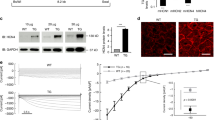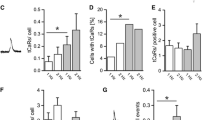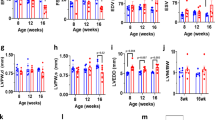Abstract
Persistent elevation of Ca2+ influx due to prolongation of the action potential (AP), chronic activation of the β-adrenergic system and molecular remodeling occurs in stressed and diseased hearts. Increases in Ca2+ influx are usually linked to prolonged myocyte action potentials and arrhythmias. However, the contribution of chronic enhancement of Cav1.2 activity on cardiac electrical remodeling and arrhythmogenicity has not been completely defined and is the subject of this study. Chronically increased Cav1.2 activity was produced with a cardiac specific, inducible double transgenic (DTG) mouse system overexpressing the β2a subunit of Cav (Cavβ2a). DTG myocytes had increased L-type Ca2+ current (ICa-L), myocyte shortening, and Ca2+ transients. DTG mice had enhanced cardiac performance, but died suddenly and prematurely. Telemetric electrocardiograms revealed shortened QT intervals in DTG mice. The action potential duration (APD) was shortened in DTG myocytes due to significant increases of potassium currents and channel abundance. However, shortened AP in DTG myocytes did not fully limit excess Ca2+ influx and increased the peak and tail ICa-L. Enhanced ICa promoted sarcoplasmic reticulum (SR) Ca2+ overload, diastolic Ca2+ sparks and waves, and increased NCX activity, causing increased occurrence of early and delayed afterdepolarizations (EADs and DADs) that may contribute to premature ventricular beats and ventricular tachycardia. AV blocks that could be related to fibrosis of the AV node were also observed. Our study suggests that increasing ICa-L does not necessarily result in AP prolongation but causes SR Ca2+ overload and fibrosis of AV node and myocardium to induce cellular arrhythmogenicity, arrhythmias, and conduction abnormalities.











Similar content being viewed by others

Abbreviations
- 4-AP:
-
4-Aminopyridine
- AP:
-
Action potential
- APD:
-
Action potential duration
- CaMK II:
-
Ca2+/Calmodulin-dependent kinase II
- Cavβ2a:
-
The β2a splicing variant of the β2 subunit of the L-type Ca2+ channel
- DAD:
-
Delayed afterdepolarization
- DTG:
-
Double transgenic
- EAD:
-
Early afterdepolarization
- ECG:
-
Electrocardiography
- ECHO:
-
Echocardiography
- FDHM:
-
Full duration at half maximum
- FWHM:
-
Full width at half maximum
- ICa-L :
-
L-type Ca2+ current
- LTCC or Cav1.2:
-
The L-type Ca2+ channel
- NCX:
-
Na+/Ca2+ Exchange
- NFAT:
-
Nuclear factor of activated T-cells
- PKA:
-
Protein kinase A
- QTc:
-
Corrected QT interval
- SQTS:
-
Short QT syndrome
- RyR2:
-
Ryanodine receptor type 2
- SR:
-
Sarcoplasmic reticulum
References
Aiba T, Tomaselli GF (2010) Electrical remodeling in the failing heart. Curr Opin Cardiol 25:29–36. doi:10.1097/HCO.0b013e328333d3d6
Anderson ME (2004) Calmodulin kinase and L-type calcium channels; a recipe for arrhythmias? Trends Cardiovasc Med 14:152–161. doi:10.1016/j.tcm.2004.02.005
Antoons G, Sipido KR (2008) Targeting calcium handling in arrhythmias. Europace 10:1364–1369. doi:10.1093/europace/eun271
Barrett CF, Tsien RW (2008) The Timothy syndrome mutation differentially affects voltage- and calcium-dependent inactivation of CaV1.2 L-type calcium channels. Proc Natl Acad Sci USA 105:2157–2162. doi:10.1073/pnas.0710501105
Barry DM, Nerbonne JM (1996) Myocardial potassium channels: electrophysiological and molecular diversity. Annu Rev Physiol 58:363–394. doi:10.1146/annurev.ph.58.030196.002051
Bassani RA, Altamirano J, Puglisi JL, Bers DM (2004) Action potential duration determines sarcoplasmic reticulum Ca2+ reloading in mammalian ventricular myocytes. J Physiol 559:593–609. doi:10.1113/jphysiol.2004.067959
Bers DM (2002) Cardiac excitation–contraction coupling. Nature 415:198–205. doi:10.1038/415198a
Bodi I, Muth JN, Hahn HS, Petrashevskaya NN, Rubio M, Koch SE, Varadi G, Schwartz A (2003) Electrical remodeling in hearts from a calcium-dependent mouse model of hypertrophy and failure: complex nature of K+ current changes and action potential duration. J Am Coll Cardiol 41:1611–1622. doi:10.1016/S0735-1097(03)00244-4
Bristow MR, Kantrowitz NE, Ginsburg R, Fowler MB (1985) Beta-adrenergic function in heart muscle disease and heart failure. J Mol Cell Cardiol 17(Suppl 2):41–52. doi:10.1016/0022-2828(85)90007-0
Chen J, Piper DR, Sanguinetti MC (2002) Voltage sensing and activation gating of HCN pacemaker channels. Trends Cardiovasc Med 12:42–45 doi: S1050173801001414 [pii]
Chen X, Nakayama H, Zhang X, Ai X, Harris DM, Tang M, Zhang H, Szeto C, Stockbower K, Berretta RM, Eckhart AD, Koch WJ, Molkentin JD, Houser SR (2011) Calcium influx through Cav1.2 is a proximal signal for pathological cardiomyocyte hypertrophy. J Mol Cell Cardiol 50:460–470. doi:10.1016/j.yjmcc.2010.11.012
Chen X, Piacentino V 3rd, Furukawa S, Goldman B, Margulies KB, Houser SR (2002) L-type Ca2+ channel density and regulation are altered in failing human ventricular myocytes and recover after support with mechanical assist devices. Circ Res 91:517–524. doi:10.1161/01.RES.0000033988.13062.7C
Chen X, Wilson RM, Kubo H, Berretta RM, Harris DM, Zhang X, Jaleel N, MacDonnell SM, Bearzi C, Tillmanns J, Trofimova I, Hosoda T, Mosna F, Cribbs L, Leri A, Kajstura J, Anversa P, Houser SR (2007) Adolescent feline heart contains a population of small, proliferative ventricular myocytes with immature physiological properties. Circ Res 100:536–544. doi:10.1161/01.RES.0000259560.39234.99
Chen X, Zhang X, Kubo H, Harris DM, Mills GD, Moyer J, Berretta R, Potts ST, Marsh JD, Houser SR (2005) Ca2+ influx-induced sarcoplasmic reticulum Ca2+ overload causes mitochondrial-dependent apoptosis in ventricular myocytes. Circ Res 97:1009–1017. doi:10.1161/01.RES.0000189270.72915.D1
Cheng EP, Yuan C, Navedo MF, Dixon RE, Nieves-Cintron M, Scott JD, Santana LF (2011) Restoration of normal L-type Ca2+ channel function during Timothy syndrome by ablation of an anchoring protein. Circ Res 109:255–261. doi:10.1161/CIRCRESAHA.111.248252
Drum BM, Dixon RE, Yuan C, Cheng EP, Santana LF (2014) Cellular mechanisms of ventricular arrhythmias in a mouse model of Timothy syndrome (long QT syndrome 8). J Mol Cell Cardiol 66:63–71. doi:10.1016/j.yjmcc.2013.10.021
Fozzard HA (1992) Afterdepolarizations and triggered activity. Basic Res Cardiol 87(Suppl 2):105–113
Gong N, Bodi I, Zobel C, Schwartz A, Molkentin JD, Backx PH (2006) Calcineurin increases cardiac transient outward K+ currents via transcriptional up-regulation of Kv4.2 channel subunits. J Biol Chem 281:38498–38506. doi:10.1074/jbc.M607774200
Goonasekera SA, Hammer K, Auger-Messier M, Bodi I, Chen X, Zhang H, Reiken S, Elrod JW, Correll RN, York AJ, Sargent MA, Hofmann F, Moosmang S, Marks AR, Houser SR, Bers DM, Molkentin JD (2012) Decreased cardiac L-type Ca(2)(+) channel activity induces hypertrophy and heart failure in mice. J Clin Invest 122:280–290. doi:10.1172/JCI58227
Hedley PL, Jorgensen P, Schlamowitz S, Wangari R, Moolman-Smook J, Brink PA, Kanters JK, Corfield VA, Christiansen M (2009) The genetic basis of long QT and short QT syndromes: a mutation update. Hum Mutat 30:1486–1511. doi:10.1002/humu.21106
Hullin R, Khan IF, Wirtz S, Mohacsi P, Varadi G, Schwartz A, Herzig S (2003) Cardiac L-type calcium channel beta-subunits expressed in human heart have differential effects on single channel characteristics. J Biol Chem 278:21623–21630. doi:10.1074/jbc.M211164200
Janczewski AM, Spurgeon HA, Lakatta EG (2002) Action potential prolongation in cardiac myocytes of old rats is an adaptation to sustain youthful intracellular Ca2+ regulation. J Mol Cell Cardiol 34:641–648. doi:10.1006/jmcc.2002.2004
Li J, Marionneau C, Zhang R, Shah V, Hell JW, Nerbonne JM, Anderson ME (2006) Calmodulin kinase II inhibition shortens action potential duration by upregulation of K+ currents. Circ Res 99:1092–1099. doi:10.1161/01.RES.0000249369.71709.5c
Liu N, Colombi B, Memmi M, Zissimopoulos S, Rizzi N, Negri S, Imbriani M, Napolitano C, Lai FA, Priori SG (2006) Arrhythmogenesis in catecholaminergic polymorphic ventricular tachycardia: insights from a RyR2 R4496C knock-in mouse model. Circ Res 99:292–298. doi:10.1161/01.RES.0000235869.50747.e1
Nakayama H, Chen X, Baines CP, Klevitsky R, Zhang X, Zhang H, Jaleel N, Chua BH, Hewett TE, Robbins J, Houser SR, Molkentin JD (2007) Ca2+- and mitochondrial-dependent cardiomyocyte necrosis as a primary mediator of heart failure. J Clin Invest 117:2431–2444. doi:10.1172/JCI31060
Nerbonne JM (2000) Molecular basis of functional voltage-gated K+ channel diversity in the mammalian myocardium. J Physiol 525 Pt 2:285–298. doi: PHY_0696 [pii]
Nerbonne JM (2004) Studying cardiac arrhythmias in the mouse—a reasonable model for probing mechanisms? Trends Cardiovasc Med 14:83–93. doi:10.1016/j.tcm.2003.12.006
Perrier E, Perrier R, Richard S, Benitah JP (2004) Ca2+ controls functional expression of the cardiac K+ transient outward current via the calcineurin pathway. J Biol Chem 279:40634–40639. doi:10.1074/jbc.M407470200
Pogwizd SM, Schlotthauer K, Li L, Yuan W, Bers DM (2001) Arrhythmogenesis and contractile dysfunction in heart failure: roles of sodium–calcium exchange, inward rectifier potassium current, and residual beta-adrenergic responsiveness. Circ Res 88:1159–1167. doi:10.1161/hh1101.091193
Rossow CF, Dilly KW, Santana LF (2006) Differential calcineurin/NFATc3 activity contributes to the Ito transmural gradient in the mouse heart. Circ Res 98:1306–1313. doi:10.1161/01.RES.0000222028.92993.10
Sah R, Ramirez RJ, Oudit GY, Gidrewicz D, Trivieri MG, Zobel C, Backx PH (2003) Regulation of cardiac excitation-contraction coupling by action potential repolarization: role of the transient outward potassium current (I(to)). J Physiol 546:5–18. doi:10.1113/jphysiol.2002.026468
Schroder E, Magyar J, Burgess D, Andres D, Satin J (2007) Chronic verapamil treatment remodels ICa, L in mouse ventricle. Am J Physiol Heart Circ Physiol 292:H1906–H1916. doi:10.1152/ajpheart.00793.2006
Song LS, Sham JS, Stern MD, Lakatta EG, Cheng H (1998) Direct measurement of SR release flux by tracking ‘Ca2+ spikes’ in rat cardiac myocytes. J Physiol 512(Pt 3):677–691. doi:10.1111/j.1469-7793.1998.677bd.x
Stroud DM, Gaussin V, Burch JB, Yu C, Mishina Y, Schneider MD, Fishman GI, Morley GE (2007) Abnormal conduction and morphology in the atrioventricular node of mice with atrioventricular canal targeted deletion of Alk3/Bmpr1a receptor. Circulation 116:2535–2543. doi:10.1161/CIRCULATIONAHA.107.696583
Tang M, Zhang X, Li Y, Guan Y, Ai X, Szeto C, Nakayama H, Zhang H, Ge S, Molkentin JD, Houser SR, Chen X (2010) Enhanced basal contractility but reduced excitation-contraction coupling efficiency and beta-adrenergic reserve of hearts with increased Cav1.2 activity. Am J Physiol Heart Circ Physiol 299:H519–H528. doi:10.1152/ajpheart.00265.2010
Xu Y, Zhang Z, Timofeyev V, Sharma D, Xu D, Tuteja D, Dong PH, Ahmmed GU, Ji Y, Shull GE, Periasamy M, Chiamvimonvat N (2005) The effects of intracellular Ca2+ on cardiac K+ channel expression and activity: novel insights from genetically altered mice. J Physiol 562:745–758. doi:10.1113/jphysiol.2004.076216
Author information
Authors and Affiliations
Corresponding author
Ethics declarations
Conflict of interest
None.
Funding sources
This study was supported by NIH and HMMI grants to JDM, NIH HL088243 and AHA 0730347N to XC.
Additional information
X. Zhang and X. Ai contributed equally to this study.
Electronic supplementary material
Below is the link to the electronic supplementary material.
395_2015_523_MOESM2_ESM.pdf
Supplemental Figure 1: Cavβ2a DTG mouse model. Cavβ2a single transgenic (STG) mice interbreed with ttA single transgenic mice to produce double transgenic mice. Offspring were screened for genotypes with the primers as shown. Four genotypes were produced in the offspring and only double transgenic (DTG) mice off doxycycline (DOX) were used as the experimental group. Mice with other genotypes were used as control mice (PDF 52 kb)
395_2015_523_MOESM3_ESM.pdf
Supplemental Figure 2: Similar properties of Ca2+ sparks were observed in control and DTG VMs. No differences in Amplitudes (A), full width at half maximum (FWHM) (B) and full duration at half maximum (FDHM) (C) of Ca2+ sparks were detected in control and DTG VMs (PDF 47 kb)
395_2015_523_MOESM4_ESM.pdf
Supplemental Figure 3: Increased amplitudes but similar time to peak of Ca2+ transients in DTG VMs at pacing frequencies of 1Hz (A and B) and 3Hz (C and D). *: p<0.05, **: p<0.01 control vs. DTG, student t-test (PDF 50 kb)
395_2015_523_MOESM5_ESM.pdf
Supplemental Figure 4: Bradycardia in a DTG mouse before its death. A mouse died during telemetric recording of ECG with bradycardia before death (PDF 111 kb)
395_2015_523_MOESM6_ESM.pdf
Supplemental Figure 5: APDs and K+ currents in Cav1.2α1c heterozygous knockout mice. (A) Action potentials recorded from one c57/bl6 control VM and one α1c +/- (α1c heterozygous knockout) VM. (B) & (C) Action potential durations (B) and maximal phase 1 decay rates of action potentials (C) in control and α1c +/- myocytes. (D)-(E) amplitudes of total K+ currents, sustained 4-AP-insensitive K+ currents and 4-AP-sensitive K+ currents at different test potentials in control and α1c +/- VMs. *: p<0.05, &: p<0.01, #: p<0.001, αlc +/- vs. control. “n” cells from “N” hearts were studied (PDF 99 kb)
395_2015_523_MOESM7_ESM.pdf
Supplemental Figure 6: K+ currents in myocytes from Cavβ2a high expression mice with heart failure. Amplitudes of total K+ currents (A), sustained 4-AP insensitive K+ currents (B) and 4-AP sensitive K+ currents (C) at different test potentials in control, LE DTG and HE DTG (with HF) myocytes. *: p<0.05, &: p<0.01, #: p<0.001, Cavβ2a HE vs. control; %: p<0.01; $: p<0.0001, Cavβ2a HE vs. Cavβ2a LE. “n” cells from “N” hearts were studied. (PDF 67 kb)
395_2015_523_MOESM8_ESM.pdf
Supplemental Figure 7: Whole-blot images of KChIP2 (A) and Kv4.3 (B). (A). The KChIP2 antibody from NeuroMab detected multiple strong bands in the high molecular weight region (>50 kDa region). However, in the region for molecular weights lower than 50 kDa, there is only one strong band corresponding to 32-35kD of KChIP2. (B). The Kv4.3 antibody from NeuroMab detected only one major band between 75–100 kDa, corresponding to Kv4.3. (PDF 410 kb)
Rights and permissions
About this article
Cite this article
Zhang, X., Ai, X., Nakayama, H. et al. Persistent increases in Ca2+ influx through Cav1.2 shortens action potential and causes Ca2+ overload-induced afterdepolarizations and arrhythmias. Basic Res Cardiol 111, 4 (2016). https://doi.org/10.1007/s00395-015-0523-4
Received:
Accepted:
Published:
DOI: https://doi.org/10.1007/s00395-015-0523-4



